Art Fairs
Director Maike Cruse on What to Expect at Art Basel
The new director discusses her vision for Art Basel, global market trends—and how to raise a wheatfield at the Messeplatz.
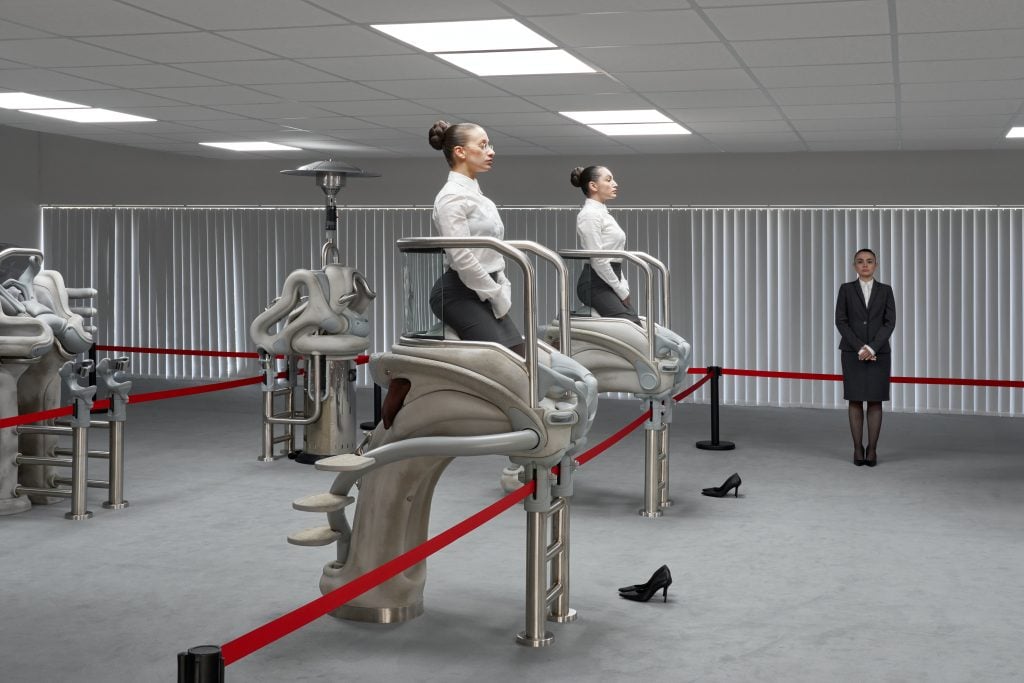
The weather is looking nice for early June along the Rhine, which is good news for Maike Cruse. The director of Art Basel’s flagship fair has a close watch on a wheat field that is currently growing at the Messeplatz—the outgrowth of a conceptual work by Agnes Denes that was originally sprouted by the World Trade Center in 1982 and has now has been sowed in Switzerland, at a central node of the art trade.
For this, a strong dose of sunshine is needed—warm, but not too warm. It seems that that is going to plan, as are all the other program elements in store for the event, which opens to VIPs next week. On Tuesday, art professionals and collectors will begin their ritualistic procession into the fair halls, where 285 galleries from the world over are presenting a vast range of projects.
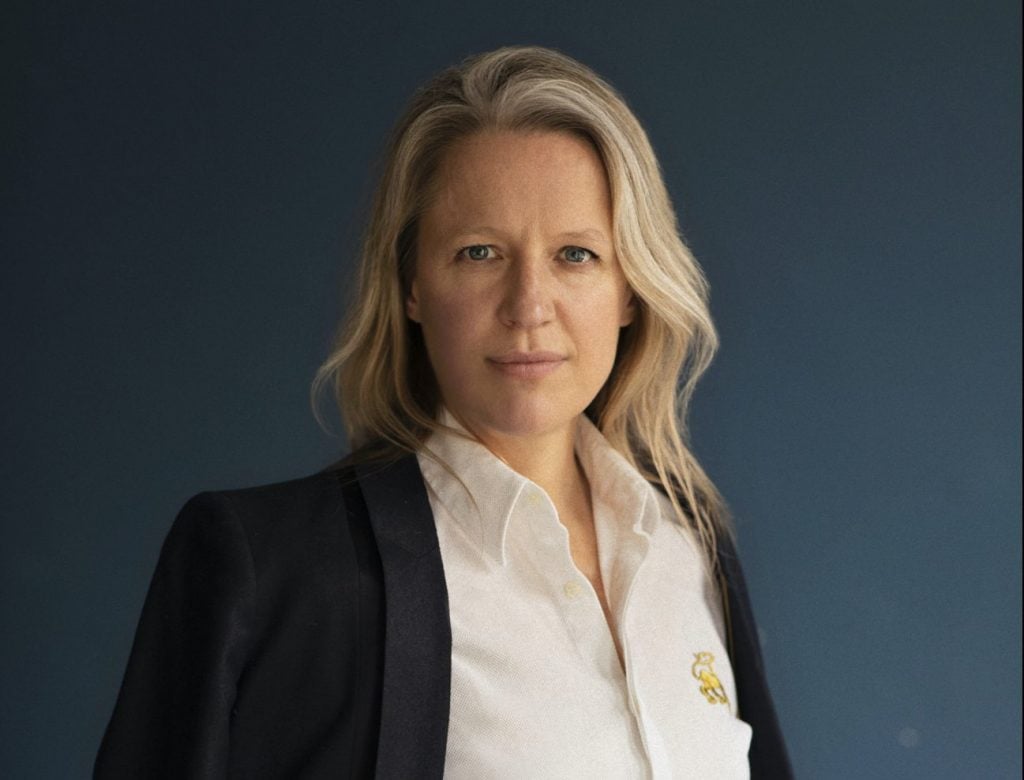
Maike Cruse. Photo: Debora Mittelstaedt. Courtesy of Art Basel.
As Cruse put final touches on her floor plan and readied herself to welcome guests among the XL-sized art that will be unveiled in the Unlimited section of the fair on Monday, I spoke to the seasoned art world figure about the evolving landscape of Basel as cultural and art market hub in Europe. We discussed what she is bringing forward from her decade steering one of the continent’s most successful art fair alternatives, Gallery Weekend Berlin, and her vision for rejuvenating certain aspects of Art Basel’s marquee fair and its tried-and-tested fair model, as well as the newly minted Art Basel Paris and wider trends in the art market.

Basel, Switzerland.
The art world in Berlin misses you. How has the transition been, leaving the Berlin art world for Basel?
I still live in both cities and my family is still in Berlin. In May, I saw nearly all the shows at Gallery Weekend Berlin and then I went back to Basel for openings at the Beyeler Foundation and the Kunstmuseum Basel. I see the best of both cities.
It’s a return to Basel, too, where you worked some 15 years ago. You held an earlier position as the fair’s communications manager. How has the city changed in the time since?
The city has changed quite a bit. The local art scene is rejuvenated. There are many project spaces now—more than there was back then. I have not even discovered them all. It has also diversified [due to] a lot of international art students in the city now. There are young galleries that opened since I left, like Weiss Falk and Galerie Müller, which will be included in the fair’s Feature section for the first time this year. Big galleries have also opened in Basel since I left the city, like Gagosian, and Hauser & Wirth, which just opened a branch. Contemporary Fine Arts Basel opened last year.
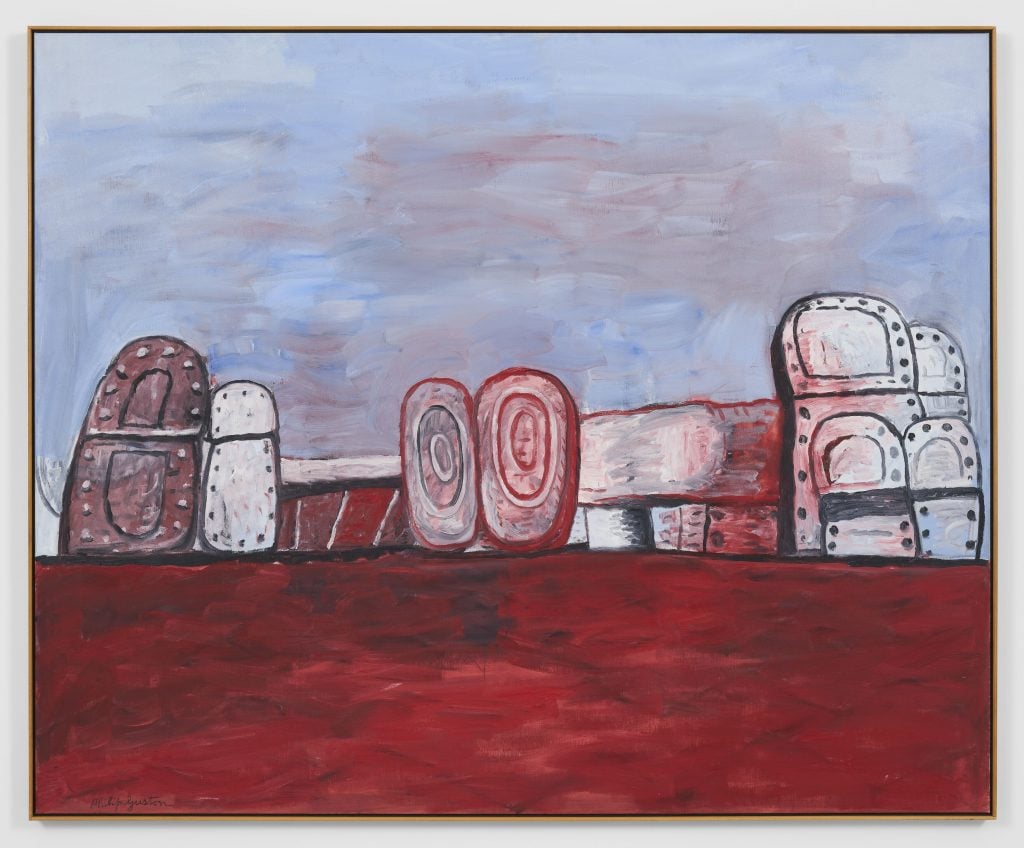
Philip Guston Orders (1978). Courtesy the Estate and Hauser & Wirth © The Estate of Philip Guston. Photo: Jon Etter
It is a testament to the health of the city when smaller enterprises and larger enterprises are both finding success there.
Absolutely.
How has the fair changed?
When I was still working there were two fairs and two directors, and now we have four fairs and a collaboration with Tokyo Art Week, as well as The Art Basel and UBS Global Art Market Report, and many other activities. We also now have one regional director for each fair, and so it really expanded quite a bit and it became truly global.
While becoming global, as you describe, regional directors help the fair focus itself on its various locales. Each director is on the ground in their respective city, more or less year-round. Can you speak a bit about your role, in that respect?
It became more important to create a regional identity of the fairs, so that each works with each other but also is differentiated from each other. In Basel, for example, we have 60 percent European galleries. In Paris, a third of our participants are from France. Already, there is a difference, but we really want to cultivate a local program and cooperate with local institutions and everything that happens in the city.
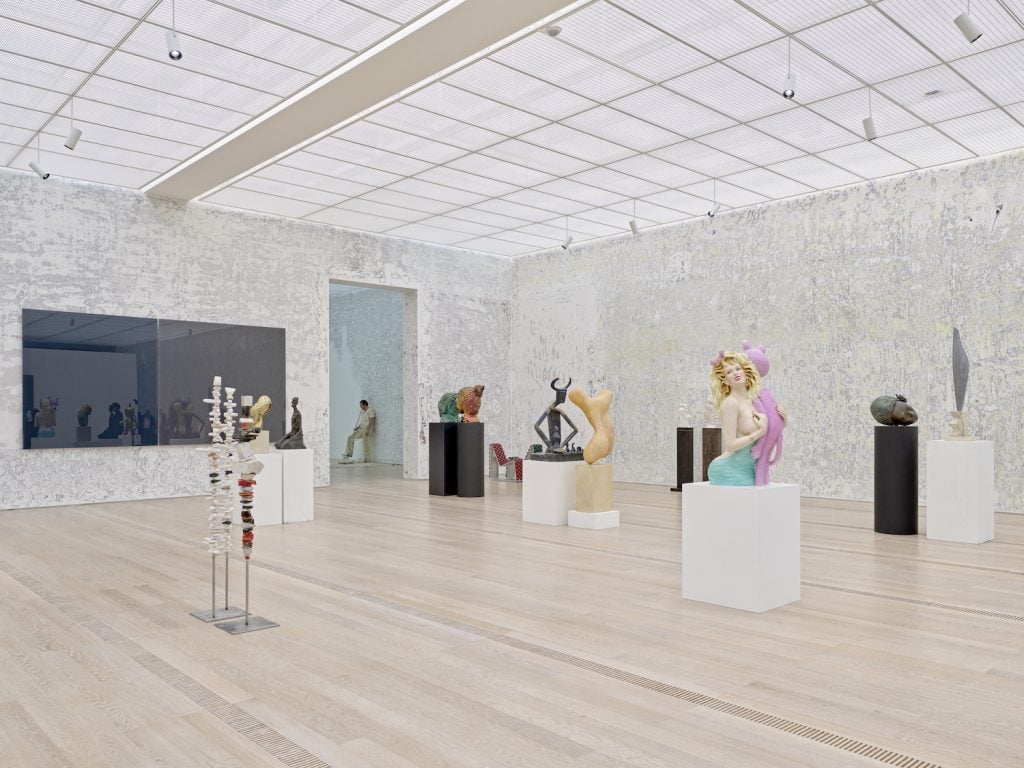
Fondation Beyeler, Riehen/Basel, 2024. © Gerhard Richter; Duane Hanson; The Easton Foundation; Succession Brancusi – All rights reserved; Enrico David; Succession Alberto Giacomett; Jeff Koons; Dozie Kanu; 2024, ProLitteris, Zürich. Photo: Mark Niedermann
Berlin Gallery Weekend became a platform that a lot of cities have tried to emulate. It is in some ways an alternative to an art fair. As such, I’m curious what kinds of lessons you learned from steering an event model like this.
We were asked by a lot of cities about the secret to Gallery Weekend Berlin’s success. My answer was always: it is not the organization but the quality of the Berlin galleries. They are the real reason for its success. It is never mainly commercially driven but about the artists and shows. Sung Tieu at Trautwein Herleth is really a show that would usually be at a museum. So, quality is the key and that is a big lesson I am bringing forward. It’s important to follow the artists and make their dreams come true. And it is important to work closely with the whole city. I’m working closely with all the institutions in Basel and the galleries. So, in a way, I am doing similar things in Basel as I did in Berlin.
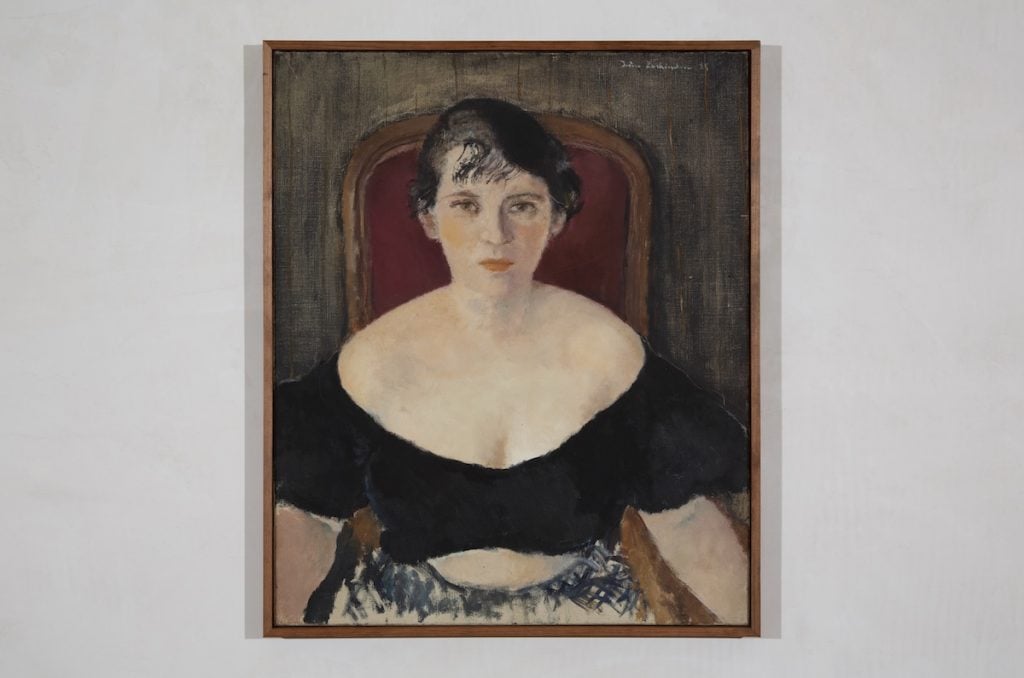
Irène Zurkinden. Courtesy Meredith Rosen and the Estate of Irène Zurkinden
One of the biggest changes at Art Basel is its expansion within Europe, which has been, by and large, successful. There is a lot of excitement around Art Basel Paris. Obviously, these are different cities and fairs, but they are still the same brand in close proximity, in terms of geography. I wonder how you are strategizing your offerings.
The Art Basel DNA remains the same: we try to create the best fair in a certain region. Regarding Paris and Basel, we believe that the European ecosystem is strong enough for two European fairs to thrive with a differentiated set of galleries. Art Basel will always remain the flagship fair, and it is also the broadest of all of our fairs with 285 participating galleries and a modern sector in addition to a specific local identity and program. We have extensive exhibitions like Unlimited and Parcours. I think that’s something very unique and we cannot copy it in any of our other cities.
Indeed, there is a lot of real estate at the Messeplatz to work with. You are also expanding beyond it, down Clarastrasse with the Parcours sector this year. I think this is a great idea. At the end of VIP day, you can find everyone you know walking down that street as they head toward dinners and drinks. It’s like a procession of dealers and collectors.
When I thought about Art Basel and its strengths, I realized that the big advantage is the city itself. There is maybe no other city, other than Venice, that’s so intimate with such a high density of high-profile art shows in walking distance. When the art world comes to town, this creates exceptional social energy. I wanted to further enhance this. We decided to expand the city-wide program, starting with bringing Parcours to Clarastrasse to connect the Messeplatz to the Merian Basel.
We will have a piece by the pioneering artist Agnes Denes, the 93-year Hungarian artist, and it is a homage to her seminal piece, the Wheatfield — A Confrontation from 1982. We’re hoping for good weather as we lead up to Art Basel for it to grow! It will remain green, but it will also remain in the city until August until it is harvested, which is also nice. We have a few pieces that will actually stay in the city longer than just the week of the fair.
We brought Parcours to Clarastrasse, curated by Stefanie Hessler from Swiss Institute. She really thought about the city of Basel and that shows—a lot of topics on view are very important for inner cities today, like circulation, transformation, and ecological processes. She selected 22 positions that will show in operational shops, hotels, restaurants, and a brewery. The shop Tropical Zone, which is a shop specialized in bringing African products to Switzerland, will be a site. Lap-See Lam will do an installation in one of the restaurants. Mandy El–Sayegh will transform an empty shopping mall on Clarastrasse with a performative piece.
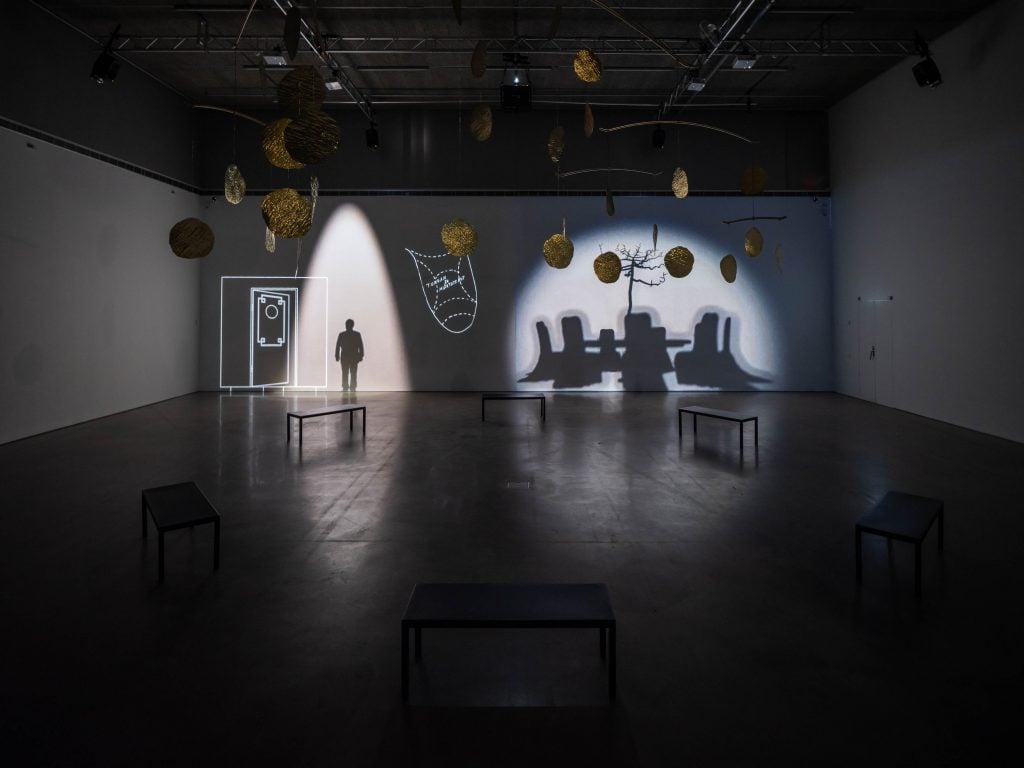
Installation View Dreamers’ Quay, Dreamers’ Key, Lap-See Lam, Bonniers Konsthall, Stockholm, 2022, photo by Jean-Baptiste Béranger, courtesy of the artist and Galerie Nordenhake Berlin, Stockholm, Mexico City. The work will be presented in the Parcours sector on Clarastrasse.
Can you describe the Merian for those who have not been to Basel?
We have a new venue that we are introducing this year. The Merian is a hotel right on the Rhine with a restaurant, hotel bar, and terrace and it will be transformed into a club. We are showing a piece on the facade by Petrit Halilaj, which we co-present with UBS. It is a star constellation that was shown for the first time at Manifesta in Prishtina. Stars will start to shine when the sun sets, and it is called When The Sun Goes Away We Paint The Sky. It refers to an essay by a young girl from Prishtina who wrote about hoping for a peaceful future.
Our program in the Merian will start in the evening, and every night it will change and be hosted by different people, including Jenny Schlenzka from Gropius Bau and Andrea Emelife from the Edo Museum of West African Art. These will be activated on the terrace, the ballroom, the club. There will be various performances and music activations every evening.
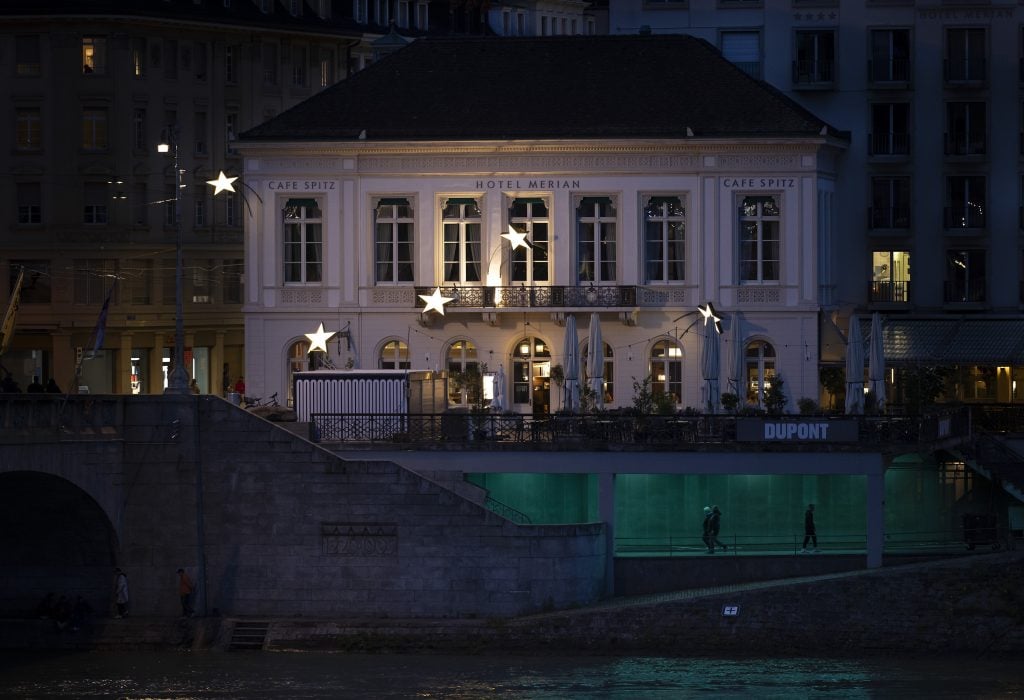
Petrit Halilaj’s artwork When The Sun Goes Away We Paint The Sky commissioned by Art Basel and UBS to mark the 30th anniversary of their partnership, installed on the façade of the former Hotel Merian, Basel, which will be a venue at Art Basel this year. Photo credit: Peter Macdiarmid for UBS
Turning to the art market, we all know that numbers and sale prices are down, as per the Art Basel & UBS Art Market Report, even as transactions are up. Then there are reports of jitters at the auctions. How do you perceive these trends from the perspective of an art fair director? What, if anything, can be done to mitigate the mood?
We all observe what our galleries observe. Everything is a little bit more cautious. There’s less urgency in the market. However, the market also showed itself to be resilient in the New York auctions. I think going towards Art Basel, it feels like dealers and collectors alike are very optimistic about the coming show. We have great responses from collectors coming from all over the world. We have collectors and museum designations from 88 countries so far. And traditionally, in the years of the fair that coincide with the Venice Biennale, we have more museum people coming, and we have more as compared with last year.
Last year, we also had a big number of Asian collectors so we expect something similar this year. Also, we have six first-time Asian participants in the gallery list. What a fair can do is create the best fair possible with the best artworks on view. And that’s what we certainly do, and the market usually follows the good quality.
It’s great to hear that there’s such a diversity. Has it reached pre-2020 levels?
Yes, regarding museum and institutional visitors, it’s actually rising. With regards to a broader public, it was still a little bit less than before last year. We had around 90,000 visitors in 2019, and around 82,000 in 2023.
That folds into my next question, about digital platforms for sales, which the art world turned to in 2020. Art Basel worked to offer alternatives during this time—has any of that digital-first offering remained?
We’ve seen also in our art market report a rise in online sales. We developed online viewing rooms. They are used widely by our galleries. We just hired a new digital officer, Craig Hepburn, who is steering this part of show. We are really transitioning more into a more holistic and accessible customer experience and focusing more on the service and providing continuous engagement year-round: a great app and great editorial. That is also cultivating the next generation of buyers. It’s important to build a pipeline and digital can play an important role in that.
Right, the art business and ways of interacting in the art market are ever-changing with shifting demographics. That brings me to new offshoot events, like Basel Social Club. What do you think these boutique concepts say about changing dynamics in the art industry?
We are in great support of Basel Social Club and really love it. It is a perfect addition to our program. There is Liste, which is also specific and very unique to Basel, where you have an art fair focused on the very best very young galleries. The Basel Social Club is great because it’s coming from the local scene and it includes many Basel-based artists. It’s more freestyle than everything else that happens in Basel. Looking at it, you can also see the necessity of people being able to come together and gather and network. That is also a reason why we introduced the Marien as an additional venue to have a space where people can meet. It will be a very nice combination with Basel Social Club. We also have a thematic link with Agnes Denes’s work and the Basel Social Club, which will take place at a farm this year.
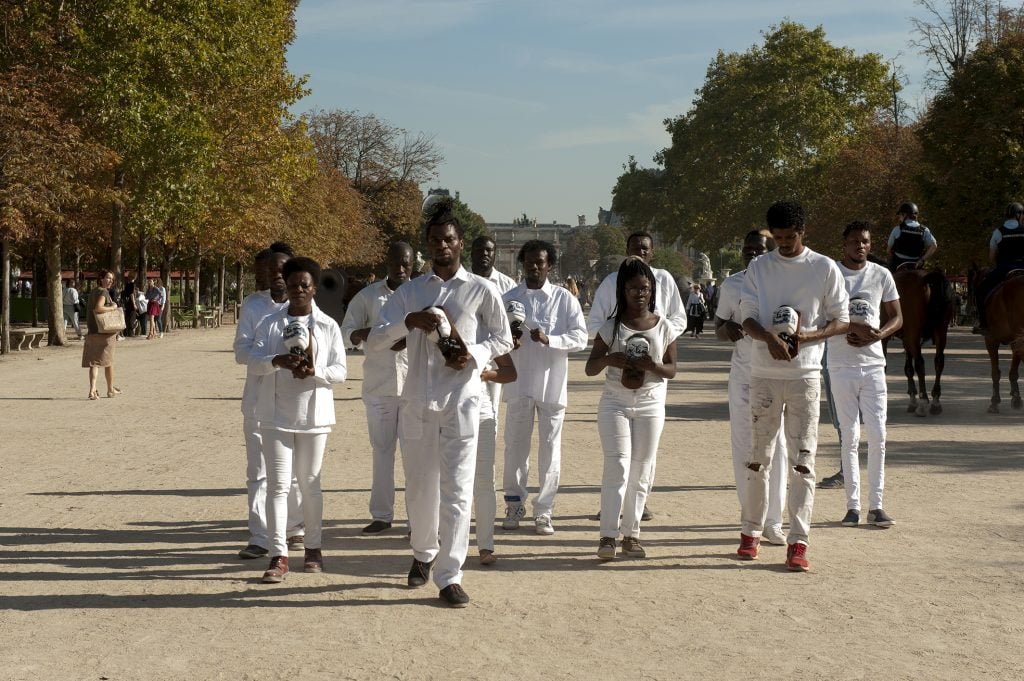
Paulo Nazareth’s Moinho de Vento / Windmill will be performed on Sunday, June 9 as part of Basel Social Club. Courtesy Mendes Wood DM.
Do you have any highlights that you’re especially excited to see in-person next week?
I think we have a fantastic selection of pieces at Unlimited this year. Among the special highlights is the groundbreaking spatial installation by Donald Judd (Gagosian), which has never been exhibited in Europe before, as well as Dan Flavin’s light installation (David Zwirner), that has a strong institutional connection to the current exhibition at the Kunstmuseum, and the 7.6-meter long work by Salvo, presented by Mazzoleni. We have [soft sculptures and mask costumes from] one of the first multimedia performances of Faith Ringgold, a 46 meter painting by Keith Haring that was shown in the 1980s; it was dispersed and it has been re-assembled now and will be shown for the first time again this year.
I am happy we chose to rejuvenate and diversify the fair much more. Tina Keng Gallery, from Taiwan, is entering our Galleries sector; Yaris, a gallery from New York focused on Color Field painting is entering the fair for the first time in the Galleries sector; of ROH projects from Jakarta will be at Statements with a sound installation by Julian Abraham. It will be a space for experimentation and for people to gather and engage and co-produce the sound. Bank Gallery, from Shanghai, at Feature presents pioneers of the soft sculpture movement. Meredith Rosen, from New York, will bring Basel artist Irene Zurkinden, who portrayed her female companions in the 1930s, various strong women.
In the Galleries sector, we are looking forward to several notable pieces, including a painting from Andy Warhol’s Death and Disaster series from the 1960s, as well as a collaborative work by Warhol and Jean-Michel Basquiat, both presented by Acquavella Galleries. Luisa Strina will feature selected works from Robert Rauschenberg’s Slide series from 1979, while Sprüth Magers will exhibit works by John Baldessari, among others. Additionally, Hauser & Wirth will showcase a work by Henry Taylor at their booth.
Art Basel opens to the public from Thursday, June 13, 2024 through Sunday, June 16, 2024.





